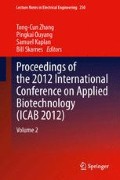Abstract
Bacillus subtilis is considered as one kind of beneficial strains which can effectively inhibit the pathogenic fungus of the plants and promote plant growth. B. subtilis wetting powder exhibited better prevention and cure of powdery mildew, phytophthora blight, gray mold, and plant growth promoting ability. B. subtilis wetting powder was formulated using diatomite and calcium carbonate as carrier, sodium dodecyl sulfate, PVA, and CMC−Na as co-formulants, soluble starch, sucrose, and sodium glutamate as protective agent. Optimal formulation recipe and processing technology of B. subtilis wetting powder were developed. The best composition was diatomite 5 %, calcium carbonate 5 %, SDS 5 %, CMC-Na 5 %, soluble starch 0.5 %, sucrose 0.5 %, and sodium glutamate 0.5 %. Quality index analysis revealed that the wetting powder reached the biological pesticide standards.
This research was supported by the Natural Science Foundation of Tianjin, China (Project No. 09JCZDJC19100). Scientific Research foundation for Doctor, Liaocheng University, China (Project No. 3010)
Access this chapter
Tax calculation will be finalised at checkout
Purchases are for personal use only
References
Fravel D, Olivain C, Alabouvette C (2003) Fusarium oxysporum and its biocontrol. New Phytol 157:493–502
Chung S, Kong H, Buyer JS et al (2008) Isolation and partial characterization of Bacillus subtilis ME488 for suppression of soilborne pathogens of cucumber and pepper. Appl Microbiol Biotechnol 80:115–123
Uppal AK, Hadrami AE, Adam LR et al (2008) Biological control of potato Verticillium wilt under controlled and field conditions using selected bacterial antagonists and plant extracts. Biol Control 44:90–100
Siddiqui IA, Shaukat SS (2004) Systemic resistance in tomato induced by biocontrol bacteria against the root-knot nematode, Meloidogyne javanica is independent of salicylic acid production. J Phytopathology 152:48–54
Ahn IP, Chung HS, Lee YH (1998) Vegetative compatibility groups and pathogenicity among isolates of Fusarium oxysporum f. sp. cucumerinum. Plant Dis 82:244–246
Wang SL, Shih IL, Wang CH et al (2002) Production of antifungal compounds from chitin by Bacillus subtilis. Enzyme Microbial Technol 31:321–328
Thilagavathi R, Saravanakumar D, Ragupathi N et al (2007) A combination of biocontrol agents improves the management of dry root rot (Macrophomina phaseolina) in greengram. Phytopathol Mediterr 46:157–167
Lee HJ, Park KH, Shim JH et al (2005) Quantitative changes of plant defense enzymes in biocontrol of pepper (Capsicium annuum L.) late blight by antagonistic Bacillus subtilis HJ927. J Microbiol Biotechnol 15:1073–1079
Kavitha S, Senthilkumar S, Gnanamanickam S et al (2005) Isolation and partial characterization of antifungal protein from Bacillus polymyxa strain VLB16. Process Biochem 40:3236–3243
Stover AG, Driks A (1999) Secretion, localization, and antibacterial activity of TasA, a Bacillus subtilis spore-associated protein. J Bacteriol 181:1664–1672
Hwang SF, Chakravarty P (1992) Potential for the integrated control of Rhizoctonia root-rot of Pisum sativum using Bacillus subtilis and a fungicide. J Plant Dis Prot 99:626–636
Chu IM, Lee C, Li TS (1992) Production and degradation of alkaline protease in batch cultures of Bacillus subtilis ATCC 14416. Enzyme Microbial Technol 14:755–761
Brannen PM, Kenney DS, Kodiak (1997) A successful biological-control product for suppression of soil-borne plant pathogens of cotton. J Ind Microbiol Biotech 19:169–171
Choudhary DK, Johri BN (2009) Interactions of Bacillus spp. and plants—with special reference to induced systemic resistance (ISR). Microbiol Res 164(5):493–513
Chen H, Yuan CL, Cai KZ et al (2008) Purification and identification of iturin A from Bacillus subtilis JA by electrospray ionization mass spectrometry. Acta Microbiologica Sinica 48:116–120
Tsuge K, Inoue S, Ano T et al (2005) Horizontal transfer of iturin A operon, itu, to Bacillus subtilis 168 and conversion into an iturin A producer. Antimicrob Agents Chemother 49:4641–4648
Wang M, Chen F, Zheng Y et al (2009) Identification and characterization of antifungal compounds produced by Bacillus subtilis B579. In: International conference of natural products and traditional medicine (TCNPTM’09), conference proceedings, pp 291–295
Chen F, Wang M, Zheng Y et al (2010) Quantitative changes of plant defense enzymes and phytohormone in biocontrol of cucumber Fusarium wilt by Bacillus subtilis B579.World J Microbiol Biotechnol 26(4):675–684
Chen F, Han D, Wang M et al (2012).Production and identification of antifungal compounds produced by Bacillus subtilis B579.In: 2012 international conference on bioinformatics and biomedical engineering, vol 4. pp 87–90
Wang J, Wang N, Gao G et al (2010) Research on wetting powder of Bacillus subtilis with each gram 20 billion spores. Agrochemicals 49(7):486–489
Collins DP, Jacobsen BJ (2003) Spatial and temporal population dynamics of a phyllosphere colonizing Bacillus subtilis biological control agent of sugar beet cercospora leaf spot. Biol Control 26(2):153–161
Shoda M (2000) Bacterial control of plant diseases. J Biosci Bioeng 89(6):515–521
Author information
Authors and Affiliations
Corresponding author
Editor information
Editors and Affiliations
Rights and permissions
Copyright information
© 2014 Springer-Verlag Berlin Heidelberg
About this paper
Cite this paper
Chen, F. et al. (2014). Preparation of Wetting Powder for Biocontrol Bacillus Subtilis . In: Zhang, TC., Ouyang, P., Kaplan, S., Skarnes, B. (eds) Proceedings of the 2012 International Conference on Applied Biotechnology (ICAB 2012). Lecture Notes in Electrical Engineering, vol 250. Springer, Berlin, Heidelberg. https://doi.org/10.1007/978-3-642-37922-2_110
Download citation
DOI: https://doi.org/10.1007/978-3-642-37922-2_110
Published:
Publisher Name: Springer, Berlin, Heidelberg
Print ISBN: 978-3-642-37921-5
Online ISBN: 978-3-642-37922-2
eBook Packages: EngineeringEngineering (R0)

